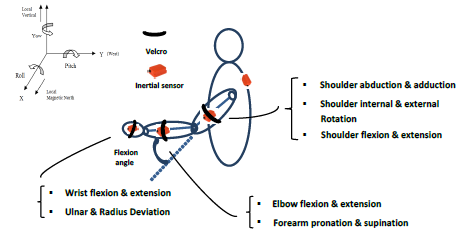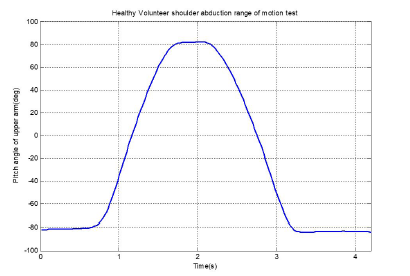Research Article 
 Creative Commons, CC-BY
Creative Commons, CC-BY
An Inertial Sensing System for Upper Limb Motion Monitoring in Neurorehabilitation
*Corresponding author: Lu Bai, School of Computing, Ulster University, Belfast, UK.
Received: October 31, 2022; Published: November 04, 2022
DOI: 10.34297/AJBSR.2022.17.002353
Abstract
Upper limb motion monitoring is vital in understanding upper limb recovery for patients who are undergoing neurorehabilitation. In recent years, there has been a growing interest in developing wearable sensing systems for human motion monitoring. In this paper, an inertial sensing system has been proposed for monitoring upper limb motion. Range of motion and position of upper limb segments are the two most important measures in assessing upper limb motion. Measurement of the range of motion of upper limb segments is based on the 3D orientation output from inertial sensors. Experiments have been done on different volunteers to evaluate the accuracy of the range of motion measurement. Kinematic modelling is based on multiple sensors and can accurately estimate the position of upper limb segments. Trajectory tracking has been done based on the position estimation results from kinematic modelling. The experimental results show that additional useful information can be obtained by using the proposed inertial sensing system.
Keywords:Upper Limb Motion Monitoring, Kinematic Modelling, Range of Motion, Trajectory Tracking
Introduction
Human upper limb motion monitoring is important, especially in the area of assessing upper limb impairment for patients who are undergoing neurological rehabilitation. Traditionally, the upper limb motion assessment methods in neurorehabilitation are subjective and rudimentary, mainly used in clinical settings. For example, Modified Ashworth Scale [1] has been widely used for upper limb spasticity measurement during the passive range of motion. For the active range of motion, Motor Assessment Scale [2] has been used to assess motor function in patients with stroke. Fugl-Meyer [3] assessment is another performance-based impairment index for assessing motor function.
With the recent development in sensing technologies, a range of different sensing systems have been used to provide objective measurement of upper limb motion, including camera-based systems [4], acoustic sensing systems [5], radio and microwave sensing systems [6], magnetic sensing systems [7] and inertial sensor-based systems [8-12]. More recently, the inertial sensing system has been widely used in upper limb motion monitoring. Also, lower cost inertial sensors are available in gaming controllers such as Nintendo Wii and Sony PlayStation Move [13,14]. These new sensing systems make it possible to assess upper limb motion remotely in a non-clinical setting. More importantly, it can provide additional insights to doctors and clinicians for monitoring the upper limb function response to a special rehabilitation regime [15,16].
Different data analysis methods and modelling techniques are used in human upper limb motion monitoring. Orientation and position are the primary parameters of interest for doctors and clinicians. For position tracking, kinematic modelling [17-19] has been proven to be an accurate method when multiple inertial sensors have been used. The Dead Reckoning (DR) algorithm has been used for position estimation of a single sensor monitoring system. Range of motion can be obtained using the 3D orientation output from the inertial sensors or calculated based on the 3D accelerometer, gyroscope and magnetometer outputs from the inertial sensors [17]. Moreover, time-frequency domain analysis [20] has been used to provide objective and additional information on upper limb movement.
Material and Methods
The primary goal of this work is to design, develop and evaluate a non-invasive multi-parameter measurement system using inertial sensors for assessing upper limb movement in patients undergoing Neurorehabilitation. This measurement system is expected to obtain more objective and repeatable measurements from the measurement subjects. As well as providing more objective data, it was expected that novel information would also be obtained concerning the trajectory and timing of segment movements that is not available with current assessment techniques. A system is developed using Xsens MTx. Two algorithms are developed to provide 3D data on limb motion. The first used Kinematic modelling, which requires the use of at least two or more sensors and can track the motion of multiple limb segments. The second applied the DR algorithm and enabled the tracking of a single limb segment using only one sensor.
Range of motion and position are the two main parameters for upper limb motion monitoring. As shown in (Figure 1), the measurement of range of motion includes shoulder abduction & adduction, shoulder internal & external rotation, shoulder flexion & extension, wrist flection & extension, ulnar & radius deviation, elbow flexion & extension, forearm pronation & supination.
The techniques were used to analyse the position tracking, orientation tracking, frequency analysis, and acceleration signals data. Position tracking using the kinematic modelling and DR algorithm has been evaluated on healthy volunteers. Range of motion tests on different volunteers have been compared between different healthy volunteers and also a dynamic plot of the range of motion test is able to show the dynamic change during a specific range of motion test. The experimental results are presented in the Results and Discussion section.
Results and Discussion
For the range of motion test, we use only one inertial sensor and attach the sensor to the upper arm segment. The expected range of shoulder abduction is 180 degrees. However, some claim that the normal range of shoulder abduction motion is between 160 degrees and 180 degrees. Some claim normative values for shoulder abduction are in the range of 150 degrees. Additionally, movement of the subjects’ clothes and hence of the sensor relative to the limb may affect the range of motion so there may be additional variation for the individual as well as from individual to individual, as shown in (Figure 2). Compared with the goniometer which has been widely used in the clinic for measurement of upper limb range of motion, the proposed system is able to provide a dynamic change of the range of motion as shown in (Figure 3).
Position tracking especially trajectory monitoring is important for doctors and clinicians to obtain additional important information from the test. The 3D position of different upper limb segments can be predicted by using the kinematic model. The position trajectory for a healthy volunteer of a Nine-Hole Peg Test (NHPT) [21] is shown in (Figure 4).
Conclusion
In this paper, a wearable system for measuring upper limb motion is proposed. The system has been used to objectively measure the position and range of motion for upper limb segments. Experiments have been done for a range of motion tests for different healthy volunteers and an NHPT for one healthy volunteer. The results show that the system is able to capture insightful information from the dynamic range of motion plot and trajectory of a healthy volunteer. Therefore the system is able to provide clinicians and researchers with a tool for research into the efficacy of current rehabilitation and new treatment regimes. This system could then be used to assess the patients’ upper limb motion performance for regular use in a general clinical environment providing additional information which is not available when using current assessment techniques.
Conflicts of interest
The author had no conflicts of interest.
References
- Bohannon RW, Smith MB (1987) Interrater reliability of a modified Ashworth scale of muscle spasticity. Phys Ther 67(2): 206-207.
- Carr JH, Shepherd RB, Nordholm L, Lynne D (1985) Investigation of a new motor assessment scale for stroke patients. Phys Ther 65(2): 175-180.
- Fugl Meyer AR, Jaasko L, Leyman I (1975) The post stroke hemiplegic patient. I. A method for evaluation of physical performance. Scand J Rehabil Med 7(1): 13-31.
- Moeslund TB, Hilton A, Krüger V (2006) A survey of advances in vision-based human motion capture and analysis. Comput Vis image Underst 104(2-3): 90-126.
- Vlasic D, Adelsberger R, Vannucci G, Barnwell J, Gross M, et al (2007) Practical motion capture in everyday surroundings. ACM Trans Graph 26(3): 35-es.
- Wilson J, Patwari N (2010) See-through walls: Motion tracking using variance-based radio tomography networks. IEEE Trans Mob Comput 10(5): 612-621.
- Fourati H, Manamanni N, Afilal L, Handrich Y (2012) Complementary observer for body segments motion capturing by inertial and magnetic sensors. IEEE/ASME Trans Mechatronics 19(1): 149-157.
- Bai L, Pepper MG, Yan Y, Spurgeon SK, Sakel M (2015) Quantitative Assessment of Upper Limb Motion in Neurorehabilitation Utilizing Inertial Sensors. IEEE Trans Neural Syst Rehabil Eng 23(2): 232-243.
- Kok M, Hol JD, Schön TB (2014) An optimization-based approach to human body motion capture using inertial sensors. IFAC Proc 47(3): 79-85.
- Lu Bai, Matthew G Pepper, Yong Yan, Malcolm Phillips, Mohamed Sakel (2020) Inertial sensor based quantitative assessment of upper limb range of motion and functionality before and after botulinum toxin: a pilot study. Glob J Eng Technol Adv 2(3): 35-44.
- Li J, Liu X, Wang Z, Zhao H, Zhang T, et al (2021) Real-time human motion capture based on wearable inertial sensor networks. IEEE Internet Things J 9(11): 8953-8966.
- Schepers HM, Roetenberg D, Veltink PH (2010) Ambulatory human motion tracking by fusion of inertial and magnetic sensing with adaptive actuation. Med Biol Eng Comput 48(1): 27-37.
- Bai L, Pepper MG, Yan Y, Phillips M, Sakel M (2020) Low Cost Inertial Sensors for the Motion Tracking and Orientation Estimation of Human Upper Limbs in Neurological Rehabilitation. IEEE Access 8: 54254 - 54268.
- Bai L, Pepper MG, Yana Y, Spurgeon SK, Sakel M (2012) Application of low cost inertial sensors to human motion analysis. In Proceedings of the 2012 IEEE I2MTC - International Instrumentation and Measurement Technology Conference Proceedings.
- Bai L, Pepper MG, Yan Y, Phillips M, Sakel M (2021) Quantitative measurement of upper limb motion pre- and post-treatment with Botulinum Toxin. Meas J Int Meas Confed 168(15): 108304.
- Braito I, Maselli M, Sgandurra G, Inguaggiato E, Beani E, et al (2018) Assessment of upper limb use in children with typical development and neurodevelopmental disorders by inertial sensors: a systematic review. J Neuroeng Rehabil 15(1): 1-18.
- Bai L (2022) 3D Orientation Estimation Using Inertial Sensors. J Electr Technol UMY 6(1): 12-21.
- Bai L, Pepper MG, Yan Y, Spurgeon SK, Sakel M et al (2011) A multi-parameter assessment tool for upper limb motion in neurorehabilitation. In Proceedings of the Conference Record - IEEE Instrumentation and Measurement Technology Conference.
- Duprey S, Naaim A, Moissenet F, Begon M, Chèze L (2017) Kinematic models of the upper limb joints for multibody kinematics optimisation: An overview J Biomech 62(6): 87-94.
- Bai L (2021) Time-Frequency Analysis of Upper Limb Motion Based on Inertial Sensors. In Proceedings of the 2021 32nd Irish Signals and Systems Conference (ISSC) 1-6.
- Mathiowetz V, Weber K, Kashman N, Volland G (1985) Adult norms for the nine-hole peg test of finger dexterity. Occup Ther J Res 57(5): 570-573.







 We use cookies to ensure you get the best experience on our website.
We use cookies to ensure you get the best experience on our website.